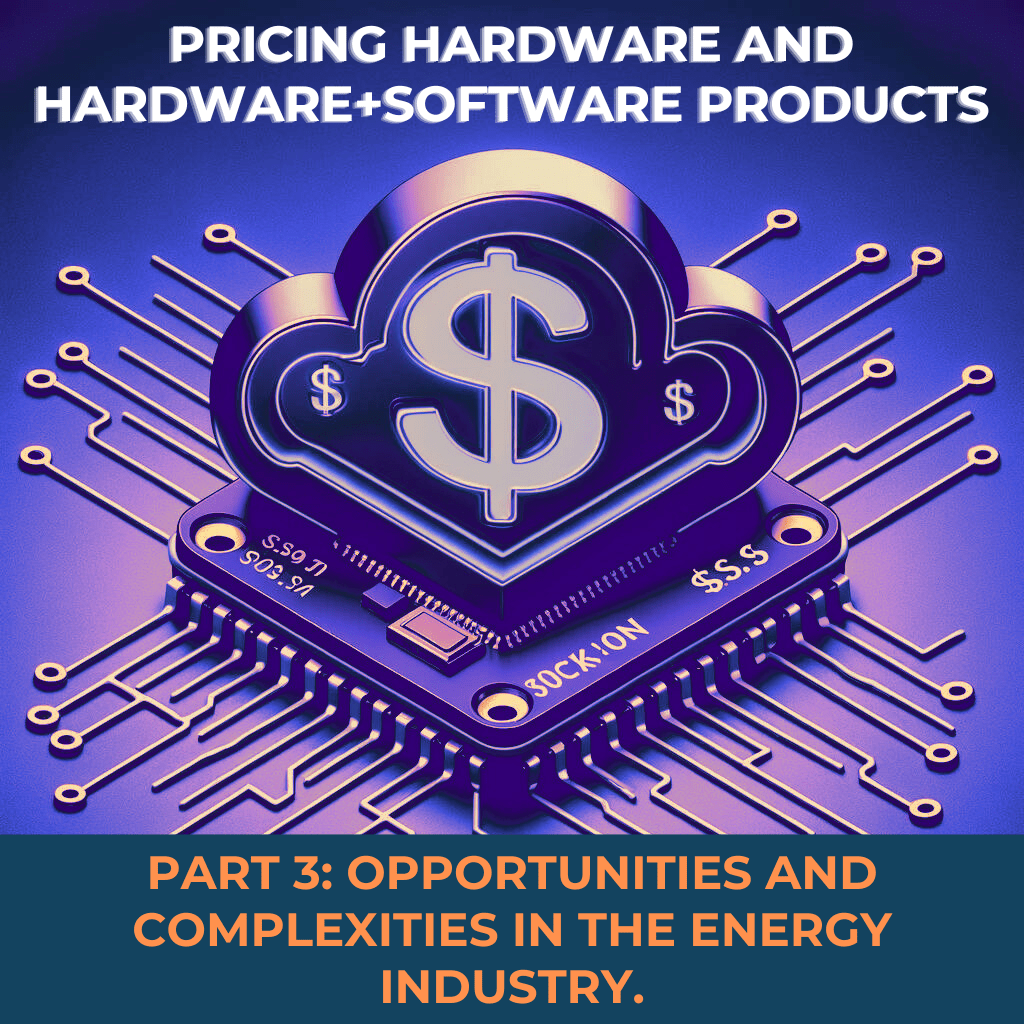Pricing Hardware and Hardware+Software Products – Part 3
Opportunities and Complexities in the Energy Industry.
Introduction
In the first part of this three-part Deep-Dive, we explored different pricing models available for Hardware and Hardware + Software Products. In the second part, we looked into the consumer value, the risks, and opportunities arising from the different hardware pricing models.
To complete this Deep-Dive, this final article will take a closer look at the energy sector—a significant playground for hardware products and a unique setup for exploring more complex pricing models involving multiple users and customers. Essentially, it is an excellent way to apply all the different options we’ve discussed in the previous parts of our analysis.
We recommend reading the three parts of this article in the correct order. If you haven’t already, start by reviewing the different Pricing Options in Part 1 and then the Pricing Risks and Opportunities in Part 2
- Part 1 – Review of Hardware and Hardware+Software pricing options
- Part 2 – Risks and Customer Value in Hardware+Software pricing models
- Part 3 – Opportunities and Complexities of Hardware+Software pricing models in the Energy industry. [this article]
Why the energy sector
Why focus on the energy sector? Recently, I’ve had the opportunity to work on several business and pricing projects within this industry. This experience revealed the complexities and the immense opportunities that innovative pricing models for hardware can bring to the energy sector.
Traditionally a straightforward industry, the energy sector has evolved into a complex ecosystem involving users, providers, manufacturers, regulators, and public incentives. This new landscape demands innovative pricing models to drive significant innovation and support.
In this article, we will explore four key areas of interest regarding pricing models in the energy sector:
- Direct Value Sharing
- From energy-hardware sales to energy-service benefits:
- Complex Relationships
- Evolutions and agility
Direct Value Sharing:
The idea that a product or service should create value and that the pricing model should enable the provider to capture part of this value is nothing new; it’s the base of so-called “value-based pricing” and is a healthy way of aligning supplier and customer incentives.
In the world of energy, for products such as heating optimizers or photovoltaic panels, this value can take the shape of cost reductions, for instance, less heating needs, and cheaper energy through PVs.
Nevertheless, a traditional ‘product sale’ pricing model, where the supplier sells the material needed to obtain these savings, is not only heavy in capital for the end user—potentially making the project prohibitive—but also risky, especially when there is no long-term incentive for the supplier.
Clearly, this is an excellent playground for “outcome-based pricing,” and more specifically what we call direct value sharing.
In outcome-based pricing, the actual price of the installation is expressed and captured as a function of the value created. In direct value sharing, this goes even further, with the supplier being compensated by accessing directly a part of the economies created thanks to their products.
This may take the form of a solar contractor installing photovoltaic panels on a customer’s (private or business) roof with little to no upfront investment by the latter. The contractor would assume the capital investment and resell electricity to the user at a lower than market rate, recovering its investment over time.
Energy-based hardware products are ideally suited for the financial model of Energy Performance Contracts (EPCs), which promote a transparent mechanism for sharing the value generated from energy savings. Contracts are often structured so that the client benefits from the savings from day one, aligning the Energy Service Company’s (ESCO) interests in maximizing efficiency gains with the client’s interest in reducing energy costs. Over time, as the ESCO recoups its investment and the contract concludes, the client enjoys the full savings benefits, solidifying this partnership’s long-term advantages.
For industries with high energy demands, EPCs offer a compelling strategy to enhance sustainability and operational efficiency without significant capital investments. This model supports environmental objectives and provides a competitive edge by optimizing energy usage and costs. For ESCOs, it represents an opportunity to differentiate their offerings and build long-term client relationships based on trust and mutual success.
From energy-hardware sales to energy-service benefits:
Investments in new infrastructure, particularly in the sustainability sector, such as mobility charging stations, often involve significant upfront costs with returns that materialize over an extended period. This delay in realizing a return on investment (ROI) can be particularly challenging for consumers and small businesses, whose financial structures typically favor quicker paybacks to maintain cash flow and ensure operational stability.
For instance, the installation of electric vehicle charging stations, while essential for the transition towards electric vehicles, requires considerable capital investment not only in the charging technology itself but also in upgrading electrical systems to support these high-power demands. The slow initial uptake of electric vehicles can further delay the realization of any financial benefits, making such investments risky for smaller entities without substantial backing.
Innovative financing models such as public-private partnerships (PPPs) and governmental subsidies can be introduced to support the initial investments to mitigate these risks. Another approach is to integrate these investments into broader service offerings, such as incorporating charging stations into commercial properties where they can add value to the existing services and attract more customers.
Moreover, in the example of charging stations, while the hardware itself is not complex (and is at risk of commoditization), the overall problem is complex both on a technical level (coordination of car loads with normal household and industrial needs) and beyond (management of bureaucracy, subsidies, authorizations). This complexity increases when the service is critical, such as when charging a car.
The general opportunity here is to move away from selling hardware to selling the benefits that come with it. For instance, in the case of charging stations, selling the service of recharging your car rather than the charging station itself.
By doing so, the advantage for the user/customer is access to a full service that includes much more than an electric box, such as managing bureaucracy and technical aspects of electric loads in buildings. Not only a hassle-free experience for the user, but most importantly the assurance that the provider has a vested interest in ensuring everything works correctly.
For businesses, this approach allows capturing a portion of the value generated, rather than competing in the commoditized hardware market.
Complex Relationships:
In residential and commercial real estate markets, relationships between stakeholders, such as property owners, tenants, and renters, often present complex scenarios, especially when introducing energy-efficient systems or sustainable practices. For example, the split incentive dilemma occurs when tenants want to charge their electric cars at home, but property owners have no incentive to facilitate this transition, as interests between society, property owners, and tenants are not aligned.
Similarly, property owners hesitate to invest in improvements like better insulation or efficient HVAC systems because tenants, who benefit from reduced energy bills, do not directly pay for these upgrades.
Fortunately, recent public sector incentives for property owners to invest in energy efficiency have reduced this burden, facilitating their investments. However, these incentives have limitations, particularly in areas with tense real estate markets where owners still have significant bargaining power over tenants.
These complex relationships also create unique opportunities for businesses to develop solutions that align the interests of all parties. One solution is the implementation of green leases, which include terms encouraging or requiring investments in sustainability and sharing the derived benefits between tenants and landlords. These might include clauses for proportionally sharing the costs and savings of energy-efficient upgrades.
Furthermore, companies can act as intermediaries to facilitate these agreements by providing energy audit services, retrofitting consultation, or even financing solutions to help overcome initial investment hurdles. By positioning themselves as partners in sustainability, businesses can foster better relationships between landlords and tenants and build a reputation for supporting green initiatives, tapping into the growing market of environmentally conscious consumers and businesses.
Lastly, real estate owners, especially those belonging to entities subject to greater scrutiny (such as funds), face increasing requirements for exemplarity, such as CO2 reduction and ESG transparency. Aligning these interests among heterogeneous parties, though non-trivial, generates new business opportunities. The pricing models sustaining these businesses will also be non-trivial and significantly deviate from a classic “hardware sale.”
Evolution and agility:
The discussion on the flexibility of pricing models becomes even more relevant when considering the evolving regulatory landscape, particularly in sectors like energy. Regulatory changes can profoundly affect market dynamics, necessitating adaptable pricing models. For example, in the energy sector, regulations regarding renewable energy incentives, carbon pricing, or efficiency standards can fundamentally alter the economic basis for pricing strategies.
At the same time, as the transition to a more sustainable world progresses, some public incentives will decrease (e.g., reduced buy-back prices for privately produced solar energy, and removal of electric car charging station subsidies). This evolution will also profoundly affect market equilibrium and require adaptable pricing models.
Businesses must be prepared to adjust their pricing models to align not only with consumer preferences and market shifts but also to comply with new regulations and leverage regulatory incentives. This necessitates a proactive approach to regulatory monitoring and an agile pricing strategy that can incorporate regulatory developments. Implementing dynamic or customizable pricing models could serve as a strategic response, allowing companies to effectively navigate regulatory changes and maintain competitiveness. This adds a layer of complexity but also presents an opportunity for differentiation and value creation in a regulated market environment.
And you?
So this was about the energy sector… whether energy is our industry or not, we all have a duty as citizens and businesses to find ways to align the interests of the world with those of our lives and our businesses for the sake of our planet.
But the world is evolving and very similar reasoning applies to other industries. Have you already thought about how moving from hardware sales to new hardware and software pricing models impacts your industry?

My name is Salva, I am a product exec and Senior Partner at Reasonable Product, a boutique Product Advisory Firm.
I write about product pricing, e-commerce/marketplaces, subscription models, and modern product organizations. I mainly engage and work in tech products, including SaaS, Marketplaces, and IoT (Hardware + Software).
My superpower is to move between ambiguity (as in creativity, innovation, opportunity, and ‘thinking out of the box’) and structure (as in ‘getting things done’ and getting real impact).
I am firmly convinced that you can help others only if you have lived the same challenges: I have been lucky enough to practice product leadership in companies of different sizes and with different product maturity. Doing product right is hard: I felt the pain myself and developed my methods to get to efficient product teams that produce meaningful work.

